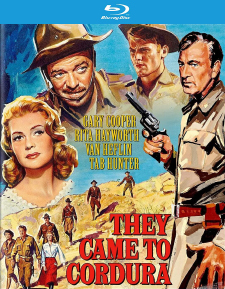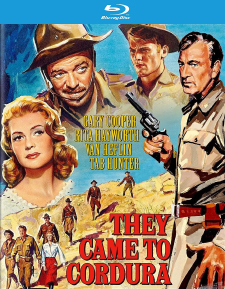They Came to Cordura (Blu-ray Review)

Director
Robert RossenRelease Date(s)
1959 (April 11, 2023)Studio(s)
Columbia Pictures (Kino Lorber Studio Classics)- Film/Program Grade: B
- Video Grade: B-
- Audio Grade: B
- Extras Grade: B
Review
They Came to Cordura was a deeply personal film for director Robert Rossen, and like many such passion projects that were produced under the Hollywood studio system, it never reached the screens in the form that he originally intended. When studios are involved, compromises frequently are made, with or without the consent of the filmmakers. Yet in a strange way, the compromised nature of the film ended up mirroring the compromises that Rossen had made in his own life, so the final cut ended up being personal in ways that he never could have imagined. Despite the deceptively simple story, there are many layers to They Came to Cordura, intentional or otherwise.
They Came to Cordura is based on the novel by Glendon Swarthout, who was inspired by his own experiences with Medal of Honor recipients during World War II. The actual story is set in 1916, when President Woodrow Wilson had sent General John J. Pershing on an unsuccessful mission into Mexico to capture Pancho Villa. Major Thorn (Gary Cooper) is a battlefield observer tasked with recommending commendations for bravery in action. During a poorly planned Army raid on a private villa, he witnesses the actions of four soldiers who he considers to be candidates for the Medal of Honor, but he ends up in conflict with the colonel in charge of the raid. As a result, he’s assigned to escort the four soldiers to the expeditionary forces base in Cordura, as well as the owner of the villa (Rita Hayworth). The arduous journey will reveal the soldiers to be anything but heroes, yet it will also raise questions about Thorn’s past, and force him to prove himself to them instead. They Came to Cordura also stars Van Heflin, Tab Hunter, Dick York, Richard Conte, and Robert Keith.
They Came to Cordura opens with a title card that says that it’s the story of the search for an answer to two of the great fundamental questions that effect mankind: What is courage? What is cowardice? Those were questions that Rossen had doubtless asked of himself many times, as he had been called before the House Un-American Activities Committee in 1947 and again in 1951, and while he answered some questions, he ultimately took the Fifth, and ended up being blacklisted. After being out of work for two years, he went back to appear before HUAC again, and this time he named names—57 of them, to be precise. His breakdown must have weighed heavily on him, so it’s easy to see why Swarthout’s book proved so appealing. The character of Major Thorn was also guilty of a moment of cowardice in his past, and his mission to reward bravery in others served as a sort of ironic atonement for that weakness.
It would be easy to dismiss They Came to Cordura as an apologia for what Rossen had done, in the same way that On The Waterfront has long been accused of being Elia Kazan’s self-justification for also naming names before the Committee. Yet the screenplay by Rossen and Ivan Moffat never feels like it’s making excuses for what Thorn had done in the past. Quite the opposite, in fact; They Came to Cordura is suffused with guilt from beginning to end. Thorn knows that he acted cowardly out of personal weakness, and the action that he takes in the film isn’t to make excuses, but rather as a way of not letting his past sins define who he is now. Sometimes, it takes courage to own up to cowardice, and Thorne ends up answering the question posed by the title card by openly acknowledging his own past weaknesses, and gaining courage out of his previous cowardice.
Unfortunately, Columbia Pictures ended up not having faith in what Rossen delivered, so when They Came to Cordura landed in the theatres in October of 1959, twenty minutes had been cut out of it. The final cut, running at 123 minutes, does unquestionably have some pacing issues, and it’s possible that the longer version would have played better—shorter doesn’t always mean faster-paced. The excised footage doesn’t appear to have been preserved, so we’ll never know for sure. As it stands, They Came to Cordura is a flawed but fascinating film that gains immeasurably on repeat viewings, and it’s a provocative examination of the nature of heroism.
Cinematographer Burnett Guffey shot They Came to Cordura on 35 mm film using anamorphic lenses, framed at 2.35:1 for its theatrical release. (Interestingly, the opening credits describe it as being a Cinemascope production, yet those same credits also acknowledge that Guffey used Panavision lenses instead.) There’s no information about the master that Kino Lorber used, but it’s an older one, possibly derived from an interpositive. It appears to be the same dated master that Mill Creek used for their The Man from the Alamo/They Came to Cordura double feature Blu-ray set, although at least in this case it’s running at a significantly higher bitrate. There’s a moderate amount of damage on display at all times, with persistent speckling and light scratches throughout the film. The colors also appear a bit faded, and the contrast range is variable—the day-for-night scenes look flat, washed out, and lacking in detail, while the few scenes that were actually shot in low-light situations do look a bit better. The improvement in bitrates does mean that this is a marginal upgrade over the Mill Creek Blu-ray, but They Came from Cordura is in desperate need of a fresh scan and some extensive cleanup work.
Audio is offered in English 2.0 mono DTS-HD Master Audio, with optional English subtitles. The audio is much cleaner than the video, and relatively free of noise or distortion. The dialogue is always comprehensible, and the score by Elie Siegmeister sounds quite good. On a personal note, Siegmeister’s Harmony and Melody, Vol. 1 & 2 were the primary textbooks when I studied music theory in college back in the Eighties, and I still have both volumes in my library to this day. They Came to Cordura was the only score that he ever wrote for a feature film, so it’s nice to hear it represented well on this disc.
Kino Lorber’s Blu-ray release includes a slipcover that matches the artwork on the insert, as well as the following extras:
- Introduction by Bertrand Tavernier (HD – 29:18)
- Trailer (SD – 2:36)
- The Plainsman Trailer (SD – 2:21)
- Vera Cruz Trailer (HD – 3:03)
- Man of the West Trailer (HD – 3:02)
- The Lady from Shanghai Trailer (SD – 1:50)
- Separate Tables Trailer (SD – 2:27)
- Tomahawk Trailer (SD – 2:20)
- Wings of the Hawk Trailer (SD – 2:13)
Aside from the trailers, there’s only one real extra on the disc, but it’s a worthy one. It’s called an Introduction by Bertrand Tavernier, but it’s not really an introduction at all for anyone unfamiliar with They Came to Cordura, so don’t watch it first if you haven’t already seen the film. Instead, it’s a comprehensive look at the film and its place in Rossen’s career. Tavernier acknowledges that it’s a strange film that feels unfinished, with writing that’s sometimes heavy and dull, yet it reveals more of itself every time that you watch it. He analyzes the film’s themes, and says that it’s a case where the heroes aren’t heroes, and the cowards aren’t cowards. He agrees that Cordura isn’t really a self-justification like On the Waterfront was. He also covers technical issues like the use of Panavision lenses, the missing footage, and even the historical context surrounding the hunt for Pancho Villa. Tavernier provides a nice capsule examination of They Came to Cordura that’s better than many full-length commentary tracks, so do give this a look—after having watched the film first, of course.
While it’s nice to get a new extra (the Mill Creek disc was bare-bones), They Came to Cordura could definitely use a little TLC in the technical department. Kino’s disc is still an improvement over Mill Creek thanks to the stronger bitrate, but this old master needs to be retired. On the other hand, They Came to Cordura is highly unlikely to ever receive further restoration work, so this is probably the best that we’ll ever get. If you own the Mill Creek disc, it may or may not be worth the upgrade to you, but if you don’t, this is currently the best way to own They Came to Cordura on home video.
- Stephen Bjork
(You can follow Stephen on social media at these links: Twitter and Facebook.)

